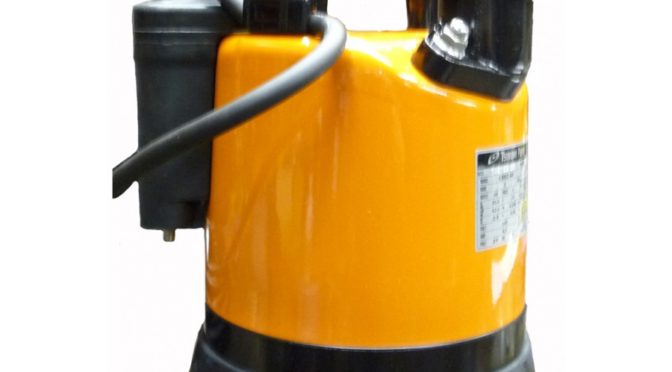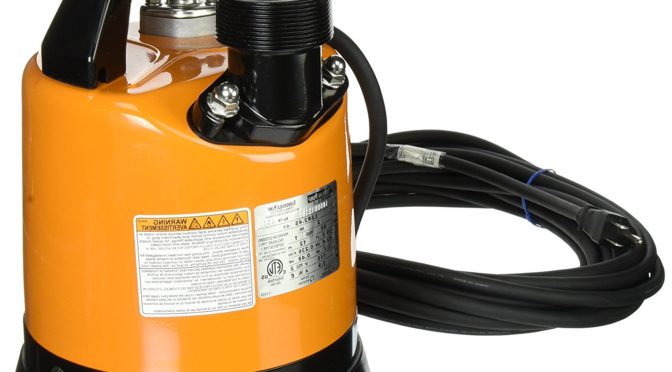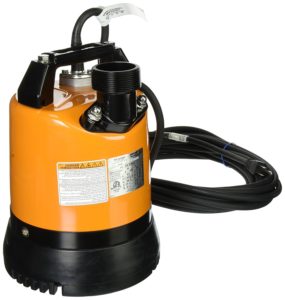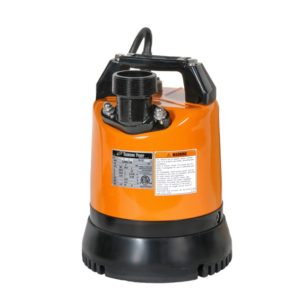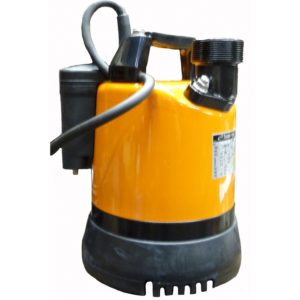 Whether you’re looking for a dewatering pump to defend personal and commercial property (e.g., preventing or mitigating basement flooding after hurricanes and flash floods) or simply to drain pools, rooftops, or similar areas, you’re going to want a good utility pump, and preferably an automatic one. So what options are out there?
Whether you’re looking for a dewatering pump to defend personal and commercial property (e.g., preventing or mitigating basement flooding after hurricanes and flash floods) or simply to drain pools, rooftops, or similar areas, you’re going to want a good utility pump, and preferably an automatic one. So what options are out there?
If you’re primarily interested in moving water instead of in removing it completely, a drain pump like the Tsurumi LB-480A-62 will get the job done quickly, automatically, and reliably. If you want water drained down to the last millimeter, you’ll want a strong low-level residue pump like the Tsurumi LSC1.45-61. However, it’s a manual pump, which requires a utility controller or constant monitoring. If you’re happy to drain water down to 1/4 inch (e.g., 6 mm) and want automatic, worry-free operation, you’ll be happy with the Tsurumi LSRA2.4S-60 Automatic Pitless Sump Pump. It’s the automatic version of the LSR2.4S-60 we recently reviewed and loved. The LSRA2 does just as good of a job without needing to be supervised. Our full review is below, and you can buy it here.
Key Features of the Tsurumi LSRA2.4S-60 Submersible Pump (60 Second Summary)
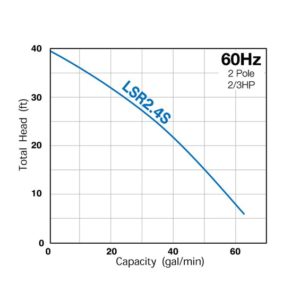 The Tsurumi LSRA2.4S-60 is an automatic low-level submersible dewatering pump; Tsurumi describes it as a pitless sump pump, which defines most drain pumps. Designed to be used indoors and outdoors, the LSRA2 is an electric utility pump designed to clear water from areas where sump pumps would be impossible or time- and cost-ineffective to install. It uses a 2/3 horsepower, 115 volt, 6.1 amp single phase motor capable of pumping water at up to 3,780 gallons per hour (63 gallons per minute) at 5 feet. The LSRA2’s pumping rate scales down to 3,000 gallons per hour at 15 feet with max head and shut-off at 40 feet. The minimum water removal level is 1/4 inch, or 6 mm above a flat surface, and the pump requires a minimum of 1/5 inch of water for continuous operation.
The Tsurumi LSRA2.4S-60 is an automatic low-level submersible dewatering pump; Tsurumi describes it as a pitless sump pump, which defines most drain pumps. Designed to be used indoors and outdoors, the LSRA2 is an electric utility pump designed to clear water from areas where sump pumps would be impossible or time- and cost-ineffective to install. It uses a 2/3 horsepower, 115 volt, 6.1 amp single phase motor capable of pumping water at up to 3,780 gallons per hour (63 gallons per minute) at 5 feet. The LSRA2’s pumping rate scales down to 3,000 gallons per hour at 15 feet with max head and shut-off at 40 feet. The minimum water removal level is 1/4 inch, or 6 mm above a flat surface, and the pump requires a minimum of 1/5 inch of water for continuous operation.
The pump is 11-15/16 inches tall, 8-1/4 inches in diameter, weighs 26 pounds, and has a power cord 32 feet long. It comes with a 2 year warranty from the purchase date and uses a 2 inch vertical (top) discharge outlet that requires a standard 2 inch hose (e.g., a PVC discharge hose); you won’t be able to directly connect it to a garden hose without an adapter. The pump includes thermal and amperage protection for the motor and a semi-vortex impeller to increase the usable life of the pump.
How Does the Tsurumi LSRA2.4S-60 Submersible Compare to Other Drainage Pumps?
 Compared to the LSR2.4S-60, the advantage of the LSRA2 instead is its inclusion of an automatic float switch that lets it turn itself on and off automatically. Since you won’t need to plug or unplug it in or connect it to a utility pump controller, you can simply turn it on and let it get to work. The minimum water draining level appears to be slightly lower at 1/4 inch vs 2/5 inch, but practically speaking, they’ll both drain water to the same level (very low) and at the same maximum speeds and to the same maximum head.
Compared to the LSR2.4S-60, the advantage of the LSRA2 instead is its inclusion of an automatic float switch that lets it turn itself on and off automatically. Since you won’t need to plug or unplug it in or connect it to a utility pump controller, you can simply turn it on and let it get to work. The minimum water draining level appears to be slightly lower at 1/4 inch vs 2/5 inch, but practically speaking, they’ll both drain water to the same level (very low) and at the same maximum speeds and to the same maximum head.
Compared to the Tsurumi LSC, the main advantage of the LSRA2 is the fact that it’s an automatic pump; you won’t need to constantly watch it the way you would with the LSC. However, the LSC, as a low-level residue pump, will drain water down to 1 mm instead of down to 6-10 mm.
Our Short and Long Term Experiences Installing and Using the Tsurumi LSRA2.4S-60 Submersible Pump
The LSRA2 will pump water in a range of situations and down to very low levels. you can use it as a water pump in both fresh and salt water environments (e.g., 15,000 gallon koi ponds or swimming pools). You can use it with streams or waterfalls, and you can also use it in rental situations or to defend property against flooding. A number of people simply buy them when moving to the gulf coast (e.g., Texas, Florida, Mississippi, Louisiana) to help keep things dry during hurricane and flood seasons. If you live in a flood zone, you’ll already want to have a good sump pump (e.g., the Zoeller M267 for an AC pump or the Basepumps CB1500 for a water-based pump). A quality dewatering pump will also pay for itself again and again if water does get past your sump pumps or if you’ve got standing water outside your house and don’t want disease-carrying mosquitoes breeding around your family and property.
Reliability appears to be high; we’d expect the average user to get several years out of a given pump. Compared to the manual LSR2, we’d expect reliability to be the same or slightly higher due to the automatic float switch negating the potential for the pump running dry if left unattended.
Troubleshooting and Installation Tips to Get Your Tsurumi LSRA2.4S-60 Submersible Working Sooner
The only issues we’ve ever come across with the LSRA2 have included the potential for the lower intake holes to become clogged with debris (e.g., sand, leaves, mud, or gravel). You’ll want to either use clean water, filter the water going into the pump, or simply check the holes and clean them out on a somewhat regular basis (e.g., monthly). You won’t damage the pump with dirty water, but if the intakes get clogged, that will slow the pump down and reduce its efficiency until they’re cleared.
Remember that if you want to use the LSRA2 with a generator, you’ll preferably want a generator with at least 3 times the amperage-delivering ability. A typical 2,700 or higher watt generator should be able to power it without trouble. We’d recommend the Champion 75537i 3100 watt generator so you can keep the pump (or any other utility or AC-powered sump pump) going when you have a power outage. Finally, remember that you’re also going to need a 2 inch discharge hose to drain water from the pump.
Tsurumi LSRA2.4S-60 Submersible Pump Pros, Cons, and Value Comparison
In conclusion, the LSRA2 resolves the main issue we had with the LSR2: needing to either manually supervise it or connect it to an automatic pump switch. As the LSRA2 is automatic, you don’t have to do anything more than plug it in, place it in water, and walk away. There are cheaper pitless sump pumps (or drainage pumps) on the market, but there are few from companies as reliable as Tsurumi. In the end, we’d rather spend twice as more on a pump that takes four times as long to break down than spend half as much on a pump that breaks twice as often. Remember that you won’t be able to completely drain water the way you would if you had a Tsurumi LSC (down to a millimeter or less), so if having every last drop gone is a priority, you’ll want the LSC instead. However, if you’re happy removing water down to a quarter of an inch and want it done automatically, you’ll be happy using the LSRA2 for many years.
You can buy the Tsurumi LSRA2.4S-60 here on Amazon. You can buy the Tsurumi LSR2.4S-60 on Amazon or here from Tsurumi. You can buy the Tsurumi LSC here. You can buy the Tsurumi LB-480A-62 here. You can buy a 2 inch PVC discharge hose here. You can buy a 3100 watt inverter generator here or a 3000 watt large-capacity generator here.
If you find our work at PumpThatSump helpful, you can support our relentless reviewing of every sump pump on the market by shopping via our Amazon link for whatever you need to make your house a home. Despite being self-employed, we promise not to spend it all on health insurance.
